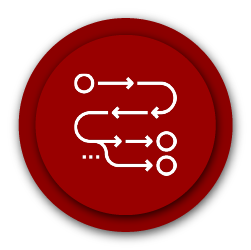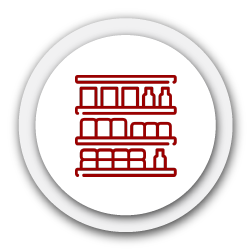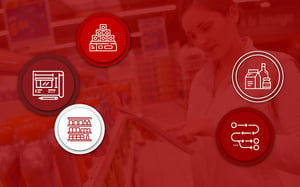John McAteer, the author of Data-driven Merchandising: Moving From An Art To A Science To Reach Today’s Shopper, understands the value of using data to inform your merchandising activities. And so do we.
To increase your sales today, you need to take care of two things:
- Optimise your retail operations; and
- Improve the customer experience.
The question remains though, how is this achievable? That’s the point of this article. In it, we will examine how you can put the array of data collected around your merchandising efforts to work for you.
Merchandising data is considered one of the most valuable tools that you can use to analyse the trends happening in and shaping your retail environment.
We’ve chosen five distinct ways or usages for this data, which will give you a clear, insightful understanding of the value and importance of this data type.
 1. Use data to decide how to spread out your categories
1. Use data to decide how to spread out your categories
Have you ever heard of the phrase “hot spots vs cold spots” in a retail environment?
This merchandising technique is a useful tool to help you determine and strategically place products across your store based on the areas where people are most likely to move.
Hot spots refer to focal points in a store - high traffic areas – which contain products that are bought on a more frequent basis. Cold spots are the areas in-store with less movement, also known as low-traffic areas.
So how does this relate to your merchandising data?
Consider that this includes:
- Sales;
- Units; and
- Profit data.
All the above are critical data sets that you can use to determine hot spot and cold spot areas in-store.
By analysing the contribution of your different categories, you can identify and strategically place the best contributing categories across your store, prompting customers to shop throughout and not only in certain areas.
That's not the only benefit. Here are a few more:
- Avoid congestion during peak trading hours;
- Increase basket share;
- Highlight promotional products; and
- Contribute to a satisfying shopping experience.
The Bread category, for example, is a traditional hotspot area as it is a popular, essential product that is bought frequently. The ideal position to place this category would be at the back of your store, as it encourages customers to first pass by other product groupings - that might lead to impulse purchases - on the way there.
Furthermore, you'd usually place the Bread category close to your Deli area - normally a cold spot area with low traffic. This strategic placement of the Bread category ensures that traffic in-store does not feel overwhelming to the customers and might lead to a more satisfying shopping experience.

2. Use data to decide on your category flow
A second way to use your merchandising data to boost your retail optimisation is by using it to help you decide on your category flow.
A category flow is the organised flow of categories or product groupings within a specific department.
You can use your merchandising data to determine category flows in-store as it allows you to identify categories, sub-categories, segments, brands and products that are the best contributing within a department.
By analysing and using your merchandising data, you can create a balance between categories with a high and low contribution. This enables you to place high-contributing product groupings strategically to attract shoppers' attention while also exposing them to those of your categories with lower sales.
A logical category flow also leads to:
- Increased customer satisfaction;
- Increased basket share; and
- Client retention.
Let's use the example of the Baby Care category. In some retail stores, this category is a high-contribution department. Within the Baby Care department, Baby Wipes are often the highest contributing category. Therefore, the flow will ideally start with Baby Bath flowing into Baby Diapers, then Baby Wipes and finally Baby clothing as this flow mimics the bath-time routine for a baby.
This logical flow puts the highest contributing category to the back of the run, enticing customers to walk through the aisle that might lead them to make more impulse purchases.

3. Use data to choose the right displays and where to place them
You can also use your merchandising data to assist in creating a display hierarchy or Consumer Decision Tree.
A Consumer Decision Tree (CDT) is an illustration that retailers can use to identify and analyse consumer buying habits and the decision-making processes followed by individuals while shopping a category.
Once established, you can also use your merchandising data to allocate space based on contribution.
On the other hand, there are the displays that you need to consider using in-store.
You can use displays to increase visibility and attract shoppers’ attention. It is worth pointing out that it's critical to identify the correct products to display on these structures since that will encourage impulse and bundle purchases, thereby increasing the average basket spend per customer.
Displays can also assist in:
- Creating brand awareness; and
- Displaying new product launches.
There are many different display types that you can use. These vary from store to store, brand to brand and product to product.
If you’re looking for a few effective displays, you can look at:
- Lightboxes placed on a run to showcase new products;
- Gondola ends for promotional purposes;
- Banners with keywords and images to draw attention;
- Basket and tables containing seasonal or occasional products.
Placing products on display increases their exposure and can be aesthetically more pleasing as this provides a more organised look.
 4. Use data to decide how to present your products on the shelf
4. Use data to decide how to present your products on the shelf
Presenting products on the shelf can be a difficult task, to say the least. It is critical to present them in a way that is both visually appealing to customers and contributes to a satisfying shopping experience.
Merchandising data makes this task less difficult. That’s because it allows you to:
- Determine which of your products are fast sellers;
- Make informed decisions when allocating space to your products;
- Place products in the correct spot on the shelf.
Think eye-level for all your popular products. By placing the products with the highest sales or potential sales at such a premium spot, you can increase your sales.
These are not the only benefits of using merchandising data to boost your retail optimisation. This data also assists you to determine the correct flow of your products within the category. If you think you’ve already read that, you have. It’s a point we unpacked above.
Cross-merchandising is another effective merchandising technique that involves displaying complementary products next to each other.
By analysing your merchandising data, you can identify the key products to cross-merchandise, which leads inevitably to an increase in sales.
Here’s an example to further explain that:
When you look at the Cereals category, Jungle Oats might have the highest sales. You’d thus want to merchandise it across an entire shelf at eye level. That makes it easily noticeable to your customers who would buy that over another brand that doesn’t have the kind of visibility on the shelf. Simple, right?
Furthermore, you could use cross-merchandising in the same run to increase basket share. That means adding a shelf with bowls close to the Cereals category.
 5. Use data to decide how much space to give your SKUs
5. Use data to decide how much space to give your SKUs
Allocating the correct amount of space to products is crucial to your success as a retailer as it will prevent you from under or overstocking certain products.
There are also other benefits here:
- Understand customer needs and habits within a specific environment: You can ensure that you display the correct products in the correct quantities, which leads to a more satisfying shopping experience.
- Complete a category analysis: You can determine the correct space allocation for each category, subcategory, brand and product. You can also clearly identify your top-contributing items.
- Ensure correct stock replenishment: You can use Days of Supply (DOS) to ensure the average coverage on your planogram is balanced so that products replenish at the same time to prevent empty shelves and frustrated customers.
Let’s consider the example of a pharmacy retailer with an Over The Counter (OTC) department.
Analgesics might be the best performing category in terms of average sales and units contribution. You would thus want to allocate more space to this category compared to your Cough, Colds and Flu category. Furthermore, with the Analgesics category, the data tells us that General Pain is the best contributing subcategory. You would thus want to provide it with the most space in the whole category.
Conclusion
It is clear that your merchandising data is a powerful tool that you can use to boost your retail optimisation. You only need to consider what we’ve covered above. With this data, you can:
- Identify hotspots in-store;
- Create logical category flows;
- Increase customer satisfaction; and
- Encourage impulse buying.
Of course, the above pointers are only a fraction of the benefits that you can enjoy when you use your data correctly. However, our point remains: if you want to see long-term success - the type that sees your retail business continually grow and improve - you need to leverage your data. Because your customers - and shareholders - will thank you for it.
Want to leverage your retail data but don’t have access to the necessary resources or specialist software? Let DotActiv help.
You can book a customised complimentary meeting with a DotActiv expert here or browse our different software editions on our online store here.
About the contributors
Corli Pretorius joined DotActiv in 2020 as a retail space planner on the Dis-Chem account. She has since changed roles to floor planner, working on the same account. She has a Bachelor of Consumer Science with Business Management from North-West University.
Déan Vermaak joined DotActiv at the beginning of 2020 as a shelf planner. He has worked at various accounts including ACDC Express (Infinity Brands). Currently, he works as a category planner on the Dis-Chem account. He has a Bachelor of Commerce in Tourism and Marketing Management from the North-West University.
Karike Pieters joined DotActiv in 2019 as a space planner for the Health and Pharmacy Department at Dis-Chem. Since then, she has changed roles to work as a floor planner. She has a BSc Degree in Consumer Science from North-West University.
Kelly Cordeiro joined DotActiv in 2017. Since joining, she has had experience running many accounts, including ACDC, Ultra Liquors, Diageo, JDE Coffee, GSK, Shield, Permoseal and Pick n Pay.
Tayla Grifo-Fanner joined DotActiv in 2016 as a retail space planner. She has worked on various accounts, including Pick n Pay. In 2020, she was promoted to the newly established Software Account Management team where she oversees various software accounts.


